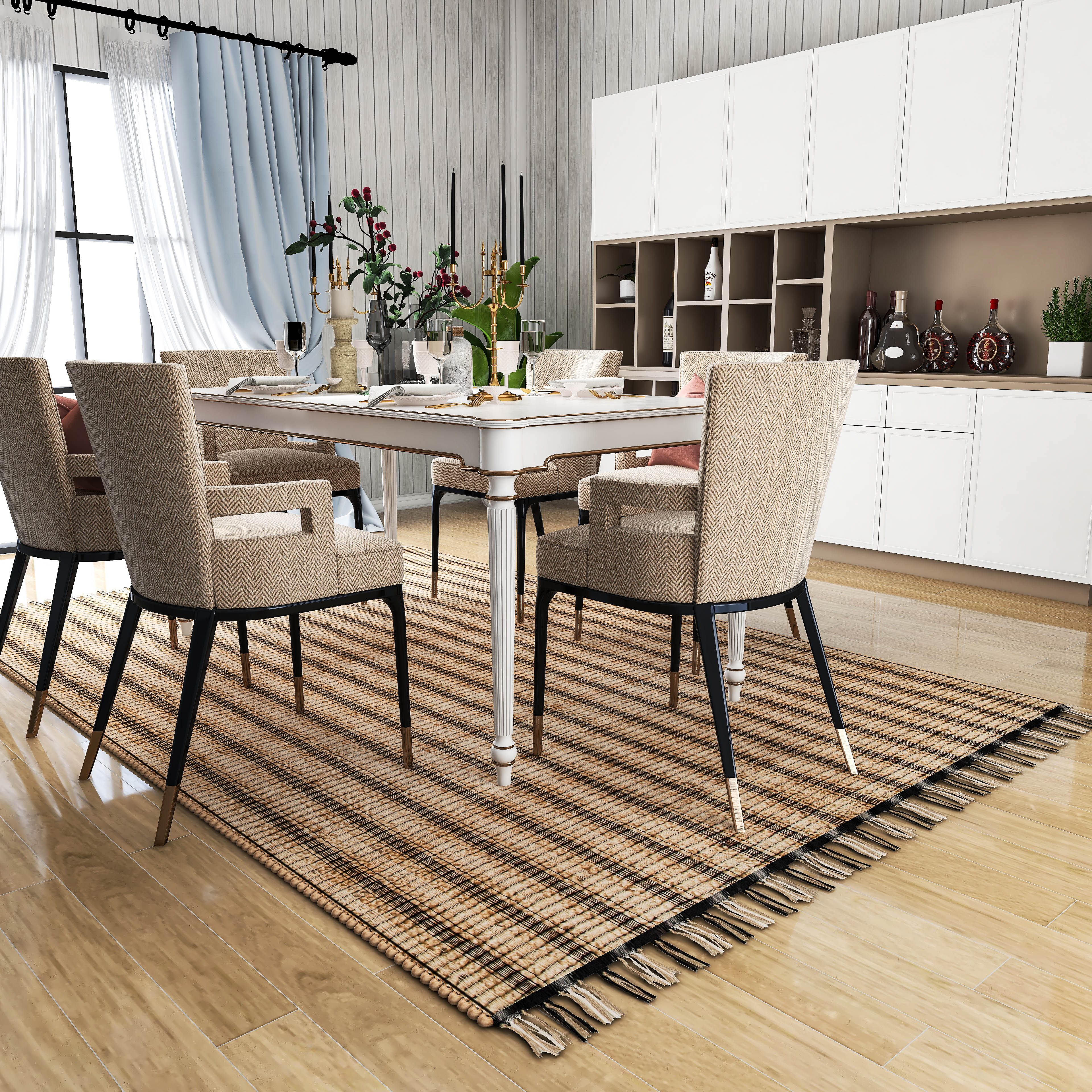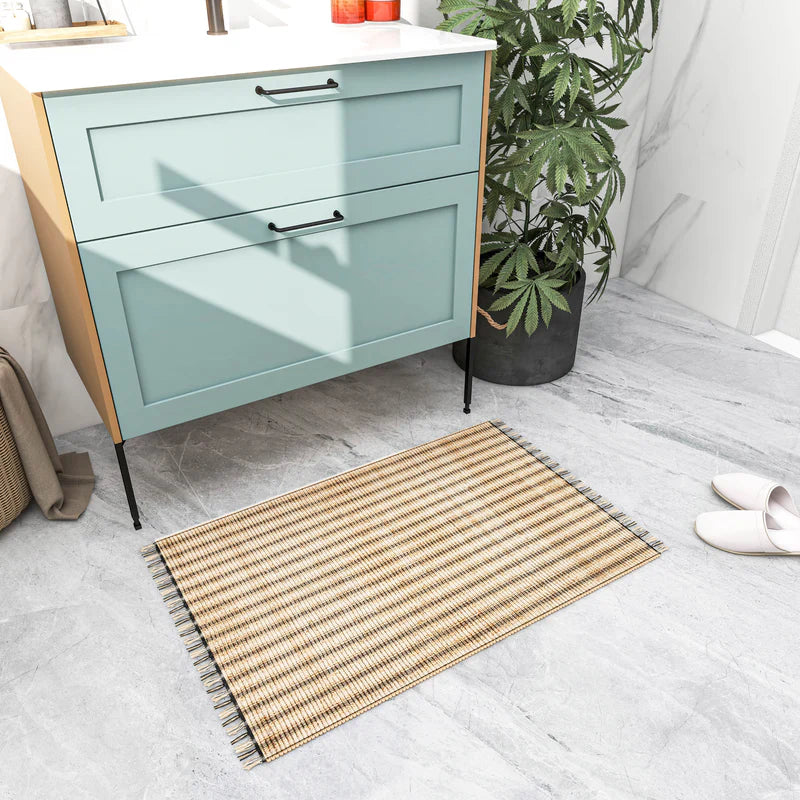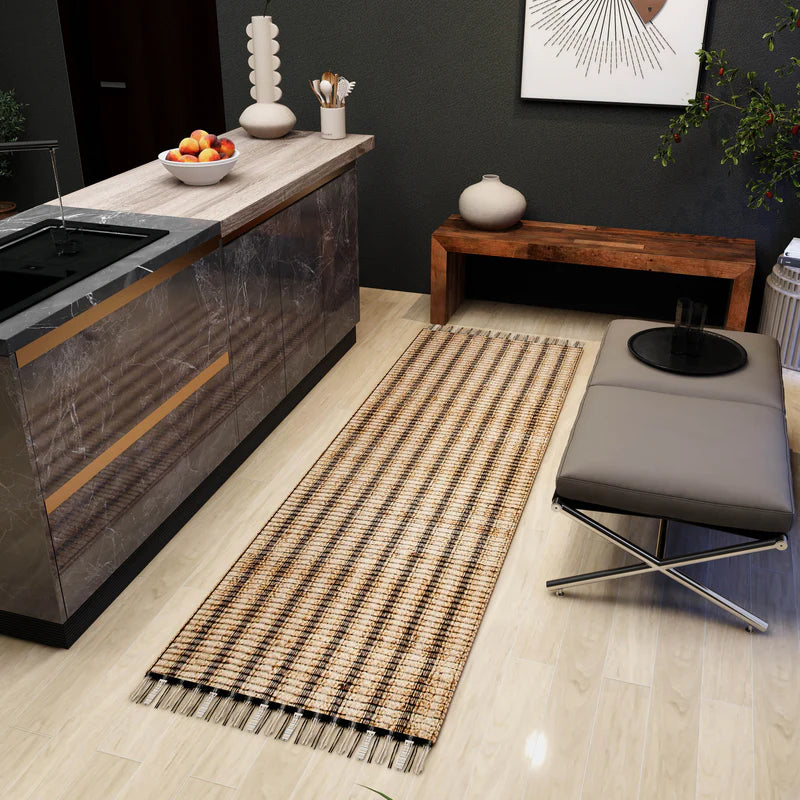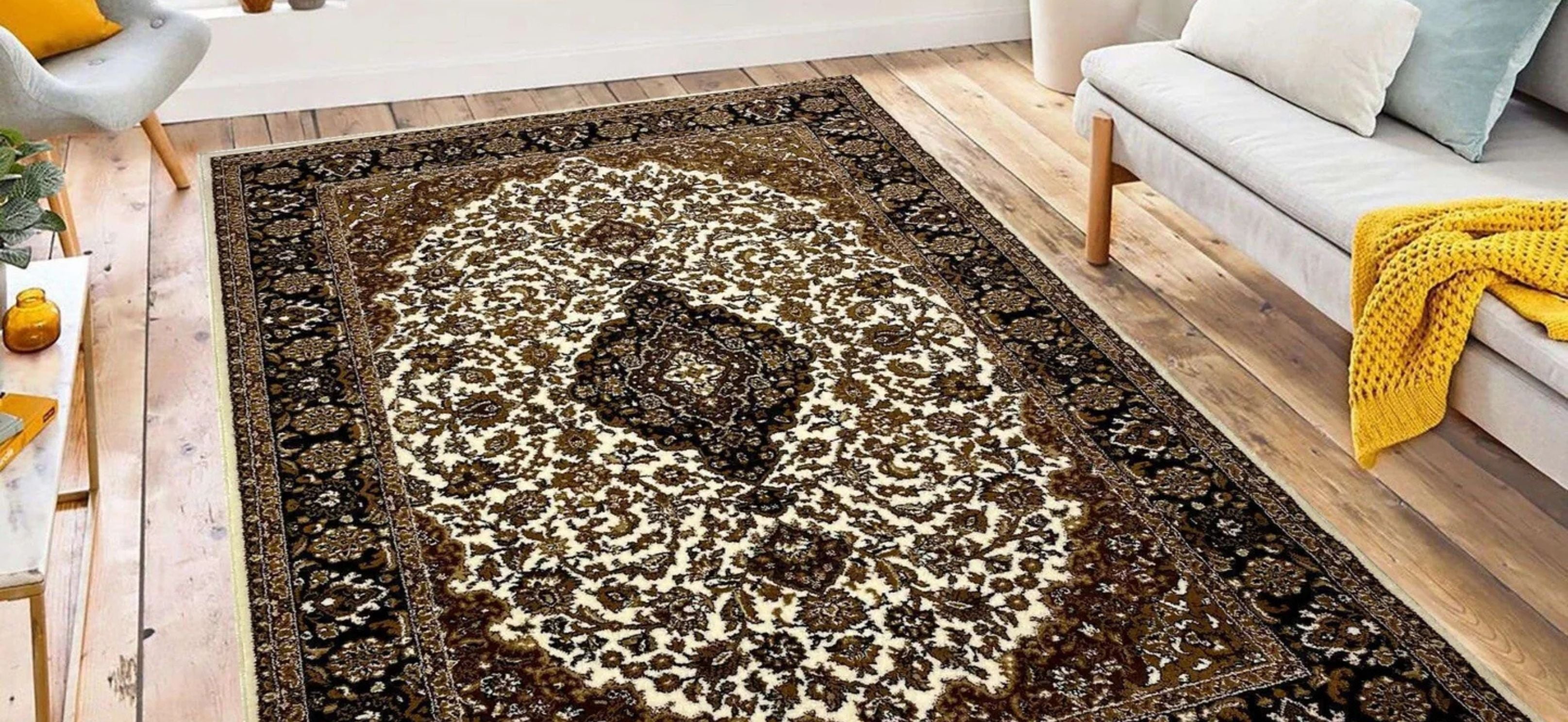Article: How to Clean a Polypropylene Rug: Easy Steps for a Fresh, Lasting Look
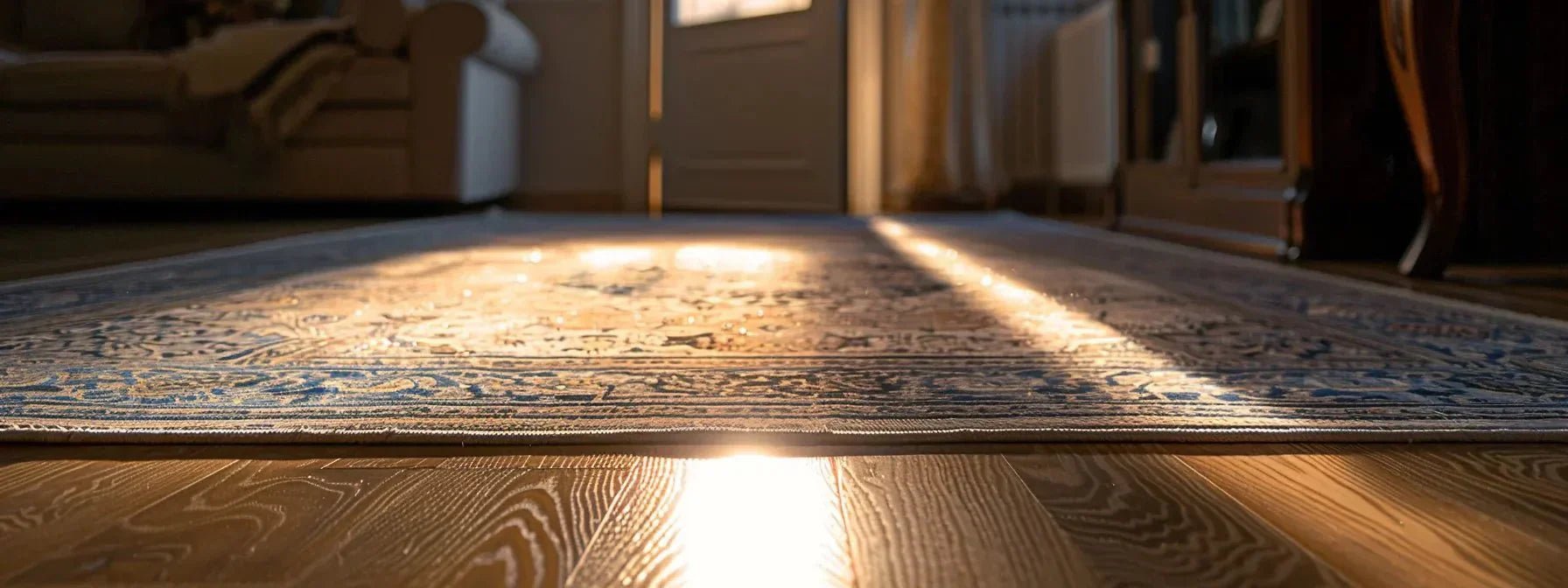
How to Clean a Polypropylene Rug: Easy Steps for a Fresh, Lasting Look
Key Takeaways:
- Vacuum First: Start with thorough vacuuming to clear loose debris.
- Use Mild Detergents: Opt for non-abrasive, pH-neutral soaps suitable for synthetic fibers.
- Tackle Stains Early: Blot spills immediately; vinegar and baking soda can handle tough stains and odors.
- Avoid Harsh Chemicals: Skip bleach and strong chemicals; they can damage fibers.
- Rinse and Dry Properly: After cleaning, rinse out soap residue, then air dry to prevent mildew.
- Preventative Measures: Use doormats, a no-shoes policy, and frequent vacuuming in high-traffic areas.
- Professional Cleaning: Schedule annual deep cleaning to extend the rug’s life and preserve quality.
Are you wrestling with the mystery of how to clean a polypropylene rug without causing damage?
Look no further. This comprehensive guide will systematically walk you through effective cleaning techniques, including the safe use of machines and mixtures that preserve your rug's integrity.
We'll reveal how to tackle common stains with ease and advise on the right products that won't apply undue pressure to the fibers. By mastering these methods, you'll ensure your polypropylene rug remains spotless, enhancing its longevity.
Whether it's routine maintenance or deep steam cleaning, this post empowers you to maintain the beauty and durability of your rug.
Learn Effective Cleaning Techniques for Polypropylene Rugs

Beginning with a thorough vacuuming eliminates loose debris from a polypropylene rug, paving the way for more specific cleaning techniques.
A soft brush can then be used to remove surface dirt, maintaining the rug's condition. Applying a mild detergent solution addresses more stubborn stains and deep-set dirt, providing an in-depth cleanse.
It's crucial to rinse the rug to clear any soap residue, employing a towel to assist in the process.
Finally, allowing the rug to air dry ensures it’s ready for use without any dampness. Throughout these steps, options like powder, shampoo, and dry cleaning can be considered based on the rug's specific needs.
Start by Vacuuming the Rug Thoroughly
Initiating the cleaning process with a vacuum cleaner sets the stage for a truly spotless polypropylene rug. It's imperative to pass your vacuum over the rug, paying special attention to high-traffic areas where dirt accumulates.
This step not only picks up loose debris but also prepares the fibers for a deeper cleaning, ensuring they're receptive to subsequent treatments.
During vacuuming, use of an attachment hose can enhance the effectiveness of the cleaning session, allowing one to address every nook of the rug comprehensively.
After vacuuming, rug owners should consider a round of steam carpet cleaning with tap water for those stubborn spots that seem impervious to standard cleaning.
A proactive approach to rug maintenance not only improves the appearance but also extends the life of the rug.
Remove Surface Dirt Using a Soft Brush
After the initial vacuuming, utilizing a soft brush to sweep the polypropylene rug can dislodge and remove embedded surface dirt that the vacuum may have missed.
Gentle strokes help protect the integrity of the rug's fibers while effectively lifting dirt, which can be collected with a paper towel for easy disposal. This step is especially important for rugs that aren't suitable for washing machine cleaning and require more manual care.
Applying the brush method allows the cleaner to target specific areas where foot traffic is frequent, ensuring a thorough clean.
For rug owners, this technique brings peace of mind, securing the knowledge that their polypropylene surface is not only visually spotless but also hygienically clean. Such meticulous care contributes to the rug's longevity and the cleanliness of the living space it enhances.
Apply a Mild Detergent Solution for Deep Cleaning
When engaging in a deeper cleanse of a polypropylene rug, applying a mild detergent solution becomes crucial for dissolving resilient stains and lifting away trapped dust.
One must blend a gentle soap with warm water to create a mixture that's tough on dirt yet gentle on color and fibers, ensuring the rug remains vibrant and intact.
After lightly scrubbing the affected areas, it's pertinent to immediately blot out the excess moisture with a clean, dry cloth to prevent watermarks and preserve the rug's texture.
For those particularly stubborn spots, a targeted application of this soap solution, followed by a soft brush or sponge, can work wonders without harming the rug's delicate composition.
Owners will find this method not only refreshes the appearance of their polypropylene rug but also revitalizes its fibers, offering a spotless outcome that feels as satisfying to the touch as it is to the eye.
Regular maintenance with this technique will contribute to the longevity and hygienic quality of the rug, tackling the common pain point of keeping high-traffic floor coverings clean.
Rinse the Rug Carefully to Remove Soap Residue
Rinsing is a pivotal step in the rug cleaning process, as it washes away any lingering cleaning agent that, if left, could attract more dirt or damage the carpet's fibers.
To effectively remove all traces of soap, one should gently spray the rug with clean water, taking care not to oversaturate the material. After this, the water should be extracted either by blotting with towels or using a wet vacuum, ensuring that no foam or residue remains, for a thoroughly clean and refreshed rug.
In managing tougher stains or high-traffic carpet areas, diluted bleach solutions can sometimes be used on polypropylene rugs due to their colorfast nature. However, this approach must be taken with caution.
Only a very light bleach solution should be sprayed onto the affected area, followed by a thorough rinse to prevent any possible weakening of the material.
This technique exemplifies a careful balance between effective stain removal and preserving the integrity of a rug's construction and appearance.
Allow the Rug to Air Dry Completely Before Use
Ensuring a polypropylene rug is completely air-dried before use is a crucial step following a wash. Skipping this stage could leave the rug damp, which might invite mold or mildew – a homeowner's nemesis.
Drying can typically be done by laying the rug flat in a well-ventilated area, ideally where airflow can promote quick evaporation of any remaining water. The suction action of the moisture into the air, rather than absorption into wool or other sensitive materials, precludes musty smells or unexpected shrinkage.
One might gently agitate the rug during the drying phase to expedite the process without the use of harsh heat, which can affect the rug's durable synthetic fibers.
In cases where liquid penetration has been deep, additional suction assistance from a wet vacuum can be employed to ensure that water is thoroughly removed from the rug's core.
Careful attention to the complete removal of detergent and water not only prevents residues but also aids in maintaining the rug's optimal condition for everyday enjoyment and use.
Tackle Common Stains on Your Polypropylene Rug Easily

For a floor covering that endures, knowing how to tackle common stains with confidence is key. Blotting spills quickly is your first line of defense to prevent them from setting into your polypropylene rug.
When these mishaps prove resistant, a vinegar solution can offer a potent remedy for stubborn stains. For persistent odors and dampness, baking soda acts like a sponge, absorbing unwanted moisture and dirt.
And if these measures don't quite hit the mark, a gentle scrub with a soft cloth can be employed to eradicate these unwelcome marks. These straightforward, practical tips will guide you through maintaining a pristine rug.
Blot Spills Immediately to Prevent Stain Setting
Timing is of the essence when dealing with spills on polypropylene rugs; prompt blotting can mean the difference between an inconspicuous spot and a permanent stain.
Experts recommend using a clean cloth or paper towel to gently dab the spill, absorbing as much liquid as possible without rubbing it into the fibers.
This immediate action stops the spill from seeping deeper into the rug, preserving its spotless condition and mitigating the risk of long-term damage.
For rug owners facing common household spills, applying pressure with an absorbent towel draws out moisture and prevents dyes from setting into the polypropylene fibers.
If a spill occurs, it's essential to address it rapidly before the liquid dries or settles. This proactive approach ensures that the rug maintains its aesthetic appeal, avoiding the need for intensive cleaning or potential discoloration that can arise from settled stains.
Use a Vinegar Solution to Treat Stubborn Stains
A vinegar solution is often rug owners' secret weapon against those challenging stains that seem impervious to other methods.
Mixing equal parts water and white vinegar creates an effective, eco-friendly cleaner that penetrates polypropylene fibers, breaking down and lifting away stains from food, mud, or even pet accidents.
After applying the solution, a gentle blot with a soft cloth can remove the stain, securing the rug's clean appearance without any harsh chemicals that could damage it.
For polypropylene rugs, stubborn stains don't have to mean despair. An application of the vinegar mixture, followed by a soft brush pass, can work wonders, disintegrating the stain's bond with the fiber and preparing it for an effortless wipe-away.
This approach not only tackles the immediate eyesore but also maintains the rug's structural integrity, ensuring its durability and the ease of future cleanings.
Apply Baking Soda to Absorb Odors and Moisture
To tackle unwanted odors and dampness in polypropylene rugs, the application of baking soda is a highly effective method. Sprinkling this household staple across the surface of the rug absorbs unpleasant scents and any residual moisture, acting like a sponge.
One should then allow the baking soda to settle for a decent period, usually a few hours or overnight, before vacuuming it up, leaving the rug odor-free and dry.
Applying baking soda not only neutralizes odors but also lightens stains with its mild abrasive properties, making it a go-to solution for rug care enthusiasts.
Its fine grains work into the fibers, drawing out dirt and moisture without the use of harsh chemicals that might degrade the rug's vibrant colors and resilient fibers.
This method serves as both a preventative measure and a spot treatment, ensuring the polypropylene rug remains in impeccable condition for daily enjoyment.
Gently Scrub the Stain With a Soft Cloth
When a straightforward blot doesn't lift a stain from a polypropylene rug, gentle scrubbing with a soft cloth can often do the trick. This method involves careful rubbing in a circular motion to ease the stain out without damaging the fibers.
Caretakers of polypropylene rugs find this technique particularly useful for preserving the rug’s structural and aesthetic integrity while effectively removing unsightly spots.
Effective stain removal requires a balance between persistence and gentleness; one might dampen the cloth with warm water or a cleaning solution for enhanced effectiveness.
The key is to work the stain out gradually, preventing the fibers from fraying or the colors from fading. This approach assures rug owners that their diligent efforts will restore the cleanliness of their enduring polypropylene rugs, extending both their beauty and lifespan.
Maintain Your Polypropylene Rug to Extend Its Lifespan
Maintaining the appearance and extending the lifespan of your polypropylene rug requires consistent care. Rotating your rug regularly prevents uneven wear, while shielding it from direct sunlight helps avoid fading.
Adding rug pads minimizes slippage and reduces stress on the fibers, and scheduling professional cleaning annually preserves its spotless state. Each of these steps contributes significantly to keeping your rug looking new and vibrant for years to come.
Rotate the Rug Regularly to Even Out Wear
Rotating a polypropylene rug periodically is a simple yet effective strategy to distribute wear more evenly across its surface.
Regular rotation helps prevent certain areas from becoming overly worn or faded, especially in rooms with high foot traffic or continuous exposure to sunlight.
This practice, infused with first-hand knowledge of rug care, allows the rug to maintain its original splendor and resilience, effectively extending its lifespan and visual appeal.
The longevity of a polypropylene rug hinges on even usage, which can be achieved by turning the rug 180 degrees every few months.
This not only mitigates the development of worn paths but also contributes to the consistent matting down of its fibers.
Owners of these sturdy rugs will find that by implementing this straightforward adjustment, the beauty and uniformity of their polypropylene floor coverings are preserved, setting the stage for lasting utility and satisfaction.
Protect the Rug From Direct Sunlight to Prevent Fading
Protecting a polypropylene rug from extensive exposure to sunlight is a simple measure that significantly mitigates the risk of fading colors.
By positioning the rug in areas where direct sunlight is minimal or utilizing window treatments to filter UV rays, owners can preserve the rug’s vibrant hues and aesthetic appeal.
This precaution is a key aspect of rug maintenance that ensures your investment remains as visually appealing as it is utilitarian, embodying the expert care it deserves.
Continuous exposure to sunlight can lead to the gradual but inevitable discoloration of even the most resilient polypropylene fibers.
Experienced rug owners often rotate their rugs in conjunction with sunlight protection as part of their regular maintenance routine.
Keeping the rug away from the harsh effects of the sun not only maintains its color integrity but also enhances the longevity and overall appearance of this household staple.
Use Rug Pads to Reduce Slippage and Wear
Introducing rug pads beneath polypropylene rugs is an essential step in both preventing slippage and reducing wear. These pads act as a buffer between the rug and the floor, anchoring the rug in place to protect users from slips and falls.
Moreover, rug pads absorb some of the impact from foot traffic, which helps preserve the rug's structure and surface condition over time.
The strategic placement of rug pads can extend the lifespan of a polypropylene rug by reducing the stress on its fibers caused by daily use.
This simple addition also ensures the rug stays smooth and flat, offering a secure walking surface that maintains its aesthetic and functional appeal. Rug owners benefit from a safer, more durable floor covering that continues to complement their living space while offering peace of mind.
Schedule Professional Cleaning Annually
Scheduling an annual professional cleaning for your polypropylene rug can significantly extend its lifespan.
Experts possess specialized equipment and techniques that deeply clean without damaging the fibers, ensuring every speck of dirt and grime is expertly removed.
This professional attention helps maintain the rug's spotless appearance and structural integrity, contributing to its durability and ongoing allure.
Enlisting professional rug cleaners offers more than just a surface-level remedy; it rejuvenates your rug from within.
They employ solutions that are not commonly available to homeowners, targeting dust mites, allergens, and deeply embedded soil that can wear down fibers over time.
Regular professional maintenance thus plays a crucial role in sustaining your polypropylene rug's pristine condition, preserving its quality and value as a focal point in your home.
Choose Safe Cleaning Products for Polypropylene Rugs

Choosing the right cleaning products is vital for maintaining a spotless polypropylene rug. Non-abrasive detergents are best for synthetic fibers, avoiding potential damage.
Harsh chemicals, including bleach, can harm rugs, so testing on a discreet section is recommended.
For a healthy home environment, eco-friendly cleaning solutions are preferable, ensuring safety and sustainability while caring for your polypropylene rug.
Select Non-Abrasive Detergents Suitable for Synthetic Fibers
Selecting the right detergent for cleaning polypropylene rugs is imperative to maintain their pristine condition.
Synthetic fibers, such as those in polypropylene rugs, require non-abrasive detergents that won't damage the fibers or strip the color.
Cleaners should seek out mild, pH-neutral liquid soaps designed for synthetic fabrics to ensure the longevity and continued vibrancy of their rugs.
Caregivers of polypropylene rugs should always spot test their chosen detergent on a hidden section of the rug to certify its suitability.
This step is a precautionary measure to avoid any potential discoloration or fiber damage, safeguarding the rug's appearance.
Non-abrasive detergents will provide a thorough clean without the harsh consequences of more potent cleaning agents, offering peace of mind and spotless results.
Avoid Using Bleach or Harsh Chemicals
Although polypropylene rugs are recognized for their resilience, the use of bleach or harsh chemicals for cleaning can lead to fiber degradation and discoloration.
These strong agents may also break down the protective coatings on the rug, increasing its susceptibility to staining and wear over time. One should carefully select cleaning products formulated for synthetic rugs that ensure a thorough clean without the risk of damage.
Expert rug caretakers understand the importance of preserving polypropylene fibers' integrity by avoiding caustic cleaners that can strip away their natural sheen and robustness.
Not only do harsh chemicals potentially harm the rug, but they can also release volatile organic compounds (VOCs) into the environment, compromising indoor air quality. Adopting a gentle cleaning regimen keeps your rug spotless while abundantly contributing to the well-being of your home's ambiance.
Test Cleaning Products on a Small Area First
Before fully committing a cleaning product to their polypropylene rug, prudent owners always perform a preliminary test on an inconspicuous area. This preemptive action safeguards against potential fiber damage or color alteration that could mar the rug's appearance.
Engaging in this simple step exemplifies the care that goes into upholding the rug’s quality, ensuring cleaning efforts lead to a brilliant, not blemished, outcome.
As a small amount of the chosen cleaner is applied to a hidden corner or underside of the rug, one observes for any adverse reactions. A clean, intact fiber post-application indicates the product's safety for broader use.
This practice empowers rug owners with the confidence that their cleaning regimen will enhance rather than compromise their polypropylene rug's spotlessness and longevity.
Opt for Eco-Friendly Cleaning Solutions
Shifting to eco-friendly cleaning solutions can immensely benefit the longevity and appearance of polypropylene rugs. Such cleaners not only safeguard the synthetic fibers from harsh chemicals but also contribute to a healthier living environment.
One's choice of a green cleaner, free from toxins and biodegradable, delivers a powerful clean that complements the durable nature of polypropylene while affirming a commitment to environmental responsibility.
Homeowners appreciate the dual functionality of eco-friendly cleaning agents, which efficiently address spills and stains on their rugs without the use of damaging substances.
Engaging in responsible cleaning practices with sustainable products reassures one that their meticulous efforts to maintain a spotless polypropylene rug also align with broader ecological values.
In doing so, one protects their rug investment and plays a part in preserving the planet's well-being.
Prevent Dirt Build-Up on Your Polypropylene Rug
To keep your polypropylene rug in immaculate condition, preventive measures are paramount. Placing doormats at entrances can significantly cut the amount of dirt tracked onto your rug.
Implementing a no-shoes policy preserves its cleanliness and extends its life. Regularly shaking out your rug outdoors and vacuuming high-traffic areas more frequently can prevent the accumulation of dirt and debris, ensuring your rug remains a spotless feature of your home décor.
These practical strategies are simple yet incredibly effective in maintaining a polypropylene rug's pristine appearance.
Place Doormats at Entrances to Reduce Dirt
The strategic placement of doormats at all entryways can be a game-changer in preventing outdoor grime from reaching your polypropylene rug.
These barriers primarily serve as the first line of defense, trapping street dirt and reducing the amount that guests and family members track across the rug's surface, thereby simplifying cleanliness maintenance and keeping the home environment spotless.
Doormats not only capture dirt but also absorb moisture from shoes, which is particularly advantageous during wet weather conditions.
By investing in high-quality doormats that effectively scrape off debris and soak up moisture, homeowners can significantly minimize the amount of contaminants that come into contact with their polypropylene rugs, leading to a cleaner home and less frequent deep cleaning sessions.
Establish a No-Shoes Policy on the Rug
Implementing a no-shoes policy is an effective strategy for those aiming to maintain their polypropylene rugs in top-notch condition.
By enforcing this rule, homeowners significantly reduce the introduction of dirt, bacteria, and abrasive substances that are routinely carried in on the soles of shoes, ensuring the longevity and pristine appearance of their rugs.
The removal of shoes before stepping onto the rug not only keeps the surface cleaner but also diminishes the routine cleaning workload.
This simple yet impactful practice aids in preserving the polypropylene fibers from unnecessary wear and staining, contributing to a cleaner home environment and a spotless rug that continues to enhance the aesthetic of the space.
Shake Out the Rug Outdoors Weekly
Weekly shaking out of polypropylene rugs is a straightforward method to dislodge dirt and maintain a cleaner surface. By taking the rug outside and giving it a vigorous shake, one can remove particles trapped within the fibers that vacuuming may miss.
This routine practice not only freshens up the rug but also prevents the accumulation of dirt that can grind into and wear down the fibers over time.
Maintaining a spotless rug becomes simpler with this weekly task, as it helps to minimize the dulling effects of daily dust and debris.
The action of shaking a rug outdoors allows for a natural airing, which in turn reduces the potential for odors and allergens to build up, thus supporting a healthier living space and prolonging the aesthetic appeal of your polypropylene rug.
Vacuum High-Traffic Areas More Frequently
Regularly vacuuming high-traffic areas can significantly reduce the accumulation of dirt and prolong the cleanliness of a polypropylene rug.
Consistency in this routine plays a pivotal role in preventing the wear and tear that comes from daily footfall, ensuring the rug retains its appearance and functional value.
By frequently passing a vacuum over areas that see more activity, one effectively safeguards the rug against the embedding of dirt and debris that can lead to premature aging.
Those who see more foot traffic on their polypropylene rug should consider scheduling extra vacuuming sessions as a practical maintenance strategy. The act of vacuuming not only lifts away loose dirt but also revives the fibers, allowing the rug to maintain its fresh, clean look.
This proactive measure is a straightforward solution to keep the rug in prime condition, welcoming guests and family members to a visibly spotless and inviting home environment.
Dry and Care for Your Polypropylene Rug After Cleaning

Caring for your polypropylene rug after a thorough wash is pivotal for preserving its spotless condition. Prompt removal of excess water with towels is essential to avoid moisture retention.
Laying the rug flat in a well-ventilated area ensures even drying without the risk of mold or odor development. It is also important to steer clear of direct heat sources that may deteriorate the rug's fibers. Once dry, a gentle brush can restore the rug's plush texture and appearance, keeping it looking its best for years to come.
Remove Excess Water Using Towels
After washing your polypropylene rug, the use of absorbent towels becomes a critical part of the drying process. Pressing towels down firmly onto the rug's surface, one enables the absorption of excess water, which speeds up the drying time and deter moisture-related issues such as mold.
This step is an effective method to transition from washing to drying, ensuring the rug remains clean, spotless, and ready for prompt reuse.
The effectiveness of towel drying is evident in its simplicity and the convenience it provides. By patting down or gently rolling towels over the rug, one can extract significant moisture without resorting to mechanical means.
Caretakers of polypropylene rugs find this method highly beneficial, as it preserves the structural integrity of the rug's fibers and prepares it for the final air-drying stage, guaranteeing a fresh appearance and longevity.
Lay the Rug Flat in a Well-Ventilated Area
After cleansing a polypropylene rug, one should lay it flat in a well-ventilated area to facilitate even drying. This method prevents warping or the development of mildew, common concerns for rug owners.
A space with ample airflow, such as a room with fans or near open windows, allows moisture to evaporate rapidly, ensuring the rug dries thoroughly and maintains its clean, fresh state.
Proper drying is critical for preserving the texture and longevity of polypropylene rugs. Encouraging owners to lay their freshly washed rugs in a spacious, air-rich environment can prevent the fibers from becoming stiff or clumping together.
It's a simple but vital step towards maintaining a rug's softness and vibrant appearance, serving as a testament to diligent, expert-approved rug care practices.
Avoid Direct Heat Sources During Drying
Avoiding direct heat sources is crucial when drying a polypropylene rug to prevent damage to the fibers. High heat can cause shrinking and melting, altering the rug's shape and texture.
Rugs should be dried away from radiators, space heaters, and direct sunlight, sustaining their form and ensuring long-term durability.
It's important for rug owners to understand the resilience of polypropylene to water-based cleaning methods, as opposed to thermal ones.
By allowing the rug to dry naturally in a temperature-controlled environment, they avoid the risks of heat stress on the fibers, thus preserving the rug's spotless aesthetic and structural integrity for future use and enjoyment.
Brush the Rug Fibers Gently After Drying
Once a polypropylene rug has entirely dried, a gentle brushing helps to rejuvenate the fibers, restoring the rug's natural fluffiness and texture. This final touch is crucial for homeowners wanting to maintain a spotless appearance.
Utilizing a soft-bristle brush, one can lightly comb over the rug's surface facilitating the fibers to reclaim their original direction and fullness, as seen when the rug was first purchased.
Brushing not only contributes to the aesthetic of a well-cared-for polypropylene rug but also assists in disentangling any mats or bends that may have formed during the cleaning process.
Engaging in this act of care after the rug is dry ensures that foot traffic and furniture placement can resume without the risk of lasting indentations or flattened areas, leaving the rug in an optimal condition for everyday enjoyment and visual appeal.
Maintaining a polypropylene rug involves a series of careful steps, from vacuuming and spot-cleaning with non-abrasive detergents to proper drying techniques that extend the rug's lifespan.
Preventive measures, such as using doormats and establishing a no-shoes policy, play a significant role in preserving the rug's condition. Employing eco-friendly solutions and scheduling annual professional cleanings not only keeps the rug looking its best but also contributes to a healthier home environment.
These expert tips, when applied regularly, ensure that polypropylene rugs remain a durable and spotless addition to any space.
FAQs
What is the best way to clean a polypropylene rug?
Vacuum regularly and use a mild soap solution for spot cleaning. For deeper cleaning, use a mixture of warm water and mild detergent, then blot dry. Polypropylene is durable and can withstand gentle scrubbing.
Are polypropylene rugs washable?
Yes, polypropylene rugs are washable and can be cleaned with mild soap and water. For larger rugs, spot cleaning is ideal, while smaller ones may be hand-washed or hosed down and air-dried.
What is the best cleaner for polypropylene?
Mild dish soap or a diluted mixture of water and vinegar works well. Avoid harsh chemicals that could affect the rug’s fibers. Spot test any cleaner first to ensure color retention and fiber integrity.
Can you steam clean a polypropylene carpet?
Yes, polypropylene carpets can be steam cleaned. However, use a low-heat setting, as high temperatures can damage the fibers. Steam cleaning can effectively remove deep-set dirt without causing harm to polypropylene.
Can you hose down a polypropylene rug?
Yes, you can hose down a polypropylene rug, as it’s water-resistant and durable. After hosing, ensure the rug is thoroughly air-dried to prevent mold or mildew from developing underneath.
What are the disadvantages of polypropylene carpet?
Polypropylene carpets can trap dirt easily, hold onto stains, and may lack the luxurious feel of natural fibers. They are also more prone to flattening under heavy furniture, and UV exposure can cause fading over time.
Can you use vinegar on polypropylene?
Yes, diluted vinegar can be used on polypropylene to remove odors or light stains. It’s safe for synthetic fibers, but always spot-test first to confirm it won’t cause discoloration.
Can you power wash a polypropylene rug?
Yes, polypropylene rugs can withstand power washing. Use a moderate pressure setting and let the rug air-dry completely afterward to prevent mold or mildew buildup from trapped moisture.
How to clean urine from a polypropylene rug?
Blot the urine immediately, then apply a mixture of mild soap or diluted vinegar with water. Let it sit briefly, then rinse and blot dry. Ensure thorough drying to prevent any lingering odor.
Should I avoid polypropylene rugs?
Polypropylene rugs are durable, affordable, and stain-resistant, making them a good choice for high-traffic areas. However, if you seek a more luxurious feel or long-lasting material, other options may be preferable.
Can polypropylene rugs get wet?
Yes, polypropylene rugs are water-resistant and can get wet. They dry relatively quickly, but ensure they’re fully air-dried after cleaning to avoid mold growth underneath.
Can you use OxiClean on a polypropylene rug?
Yes, OxiClean can be used on polypropylene rugs for stain removal. Use it in a diluted form, and always spot-test first to check for colorfastness before applying broadly.





